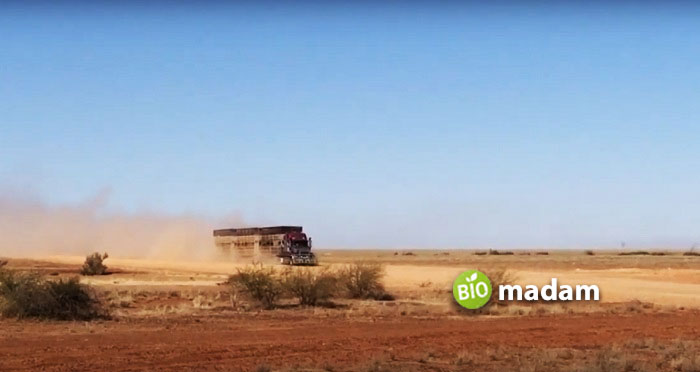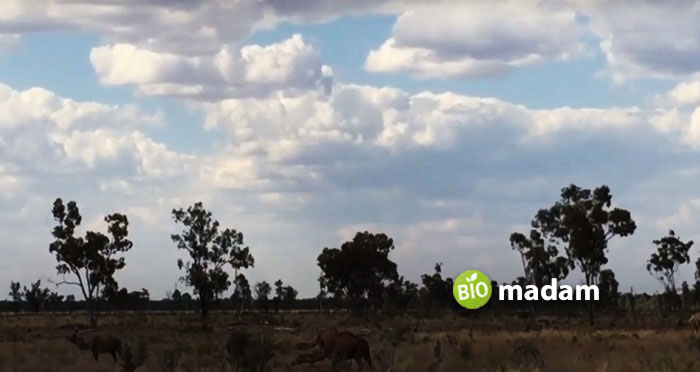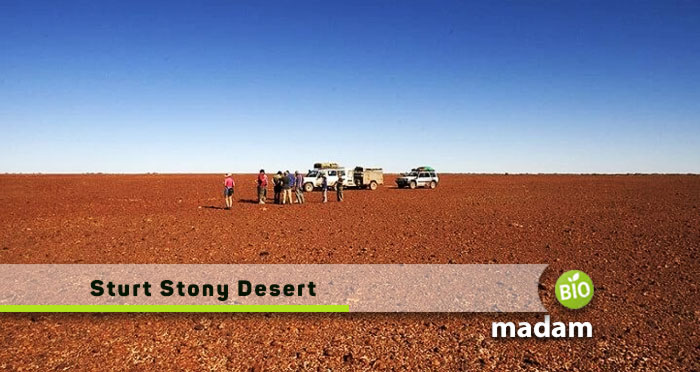Beyond sealed roads lies the rugged heart of Australia – the remote Sturt Stony Desert. This expanse of red plains and stony rises stretches across northwest New South Wales and northeast South Australia. The sheer vastness humbled early explorers, but for adventurers, rewards await. Follow dirt tracks to uncover sacred Indigenous sites and marvel at night skies filled with stars. From Crackling Soil National Park to Gason Dome, discover ever-changing landscapes first crossed by Charles Sturt’s 1844 expedition.
Though desolate, the beauty and solitude of this baked land feel suspended in time. Here, the outback’s timeless vistas let the soul wander freely. A journey to the Sturt Stony Desert leads to space and freedom, for those seeking Australia’s remote heart.
Where is the Sturt Stony Desert?
The Sturt Stony Desert sprawls across South Australia, Queensland, and New South Wales, adjoining the larger Simpson and Strzelecki Deserts. Charles Sturt first crossed this remote wasteland in 1844-45 while searching for the mythical inland sea. Today, the Birdsville Track provides access to this arid landscape of sandy plains and stony rises. With scant rainfall, vegetation is limited. Yet for adventurous travelers, the harsh beauty of the desert beckons. Though largely unpopulated, opportunities exist for four-wheel driving, hiking, and camping within its 20,000 square kilometers. The Sturt Stony Desert remains an isolated outlier in the Australian Outback, rewarding those willing to properly plan for its austere conditions.
Landscape and Geological Marvels
The Sturt Stony Desert showcases a captivating landscape with gibber plains – closely packed stones that dominate the terrain. Back in 1844, Charles Sturt, exploring this challenging area, thought these plains were shaped by ancient currents on a seafloor. However, they actually originated from weathered desert sandstone sheets, telling a unique geological story. The glistening stones, a result of this process, create a mesmerizing sight under the desert sun.
Adding to the charm are circular and stepped gilgai – small wetlands scattered across the desert. These formations, not commonly found in arid landscapes, contribute to the distinctiveness of the Sturt Stony Desert. The interplay of light on the stones and the presence of these geological marvels make this desert truly enchanting, adding to its mysterious allure.

Ecology and Biodiversity
Nestled within the Tirari-Sturt Stony desert ecoregion, the Sturt Stony Desert defies the notion of a lifeless wasteland, showcasing a remarkable array of life adapted to its harsh conditions.
Flora and Fauna
- Kowari (Dasyuroides byrnei): Thriving in the Sturt Stony Desert, this native carnivorous marsupial adeptly navigates the challenging landscape, highlighting remarkable adaptations for survival.
- Unique Flora Adaptations: Sparse acacia shrubland, bladder saltbush, and barley Mitchell grass populate the gibber plains, showcasing flora’s ability to thrive in arid conditions. Sandhill cane-grass and sandhill wattle cover scattered red sand dunes, contributing to plant life diversity.
Wildlife Diversity
The desert teems with a diverse array of wildlife, adding dynamism to its rugged beauty:
- Wedge-tailed Eagles: Graceful aviators command the skies above the desert, symbolizing the region’s untamed spirit.
- Yellow-footed Rock Wallabies: Agile marsupials gracefully navigate the rocky terrain, showcasing their adaptability to the challenging landscape.
- Western Grey Kangaroos: Iconic inhabitants adapted to the arid environment, adding a sense of Australian wilderness to the desert.
- Long-haired Rat: Occasionally undergoing population booms, this native rodent adds an extraordinary element to the desert’s dynamics, creating fascinating ecological fluctuations.
Endemic Species
The Sturt Stony Desert boasts unique endemic species, each contributing to the region’s distinctive biodiversity:
- Pickard’s Wattle: A distinctive plant species, that adds botanical uniqueness to the desert’s ecosystem.
- Fawn Hopping-Mouse: A small, agile rodent perfectly adapted to the arid landscape, showcasing the diversity of desert-dwelling mammals.
- Stony Downs Skink: An endemic reptilian resident, highlighting the desert’s reptilian diversity.
- Plains Wanderer: A unique bird species making the Sturt Stony Desert its exclusive home, symbolizing the desert’s rich avian biodiversity.
Botanical Landscape
Beyond its fauna, the desert unfolds in patches of chenopod, mallee, and mulga wooded scrubland, contributing to the overall ecological complexity of this arid landscape. The varied botanical landscape plays a crucial role in supporting the diverse animal life that calls the Sturt Stony Desert home.
Sturt Stony Desert Climate and Temperature Extremes
The Sturt Stony Desert stands as one of the clearest places in Australia, characterized by exceptionally high numbers of clear days and a striking absence of clouds. The climate in this arid expanse is marked by far below-average rainfall and humidity levels, cementing its status as a desert town with only 169mm of annual rainfall. This desert experiences both extreme heat and relatively cooler temperatures, depending on the season.
Summer (December – February)
During the summer months, the Sturt Stony Desert experiences searing daytime temperatures, with averages ranging between 37.7 and 38.8°C. Nights are relatively warm, with minimum temperatures averaging between 22.5 and 24.3°C. The hottest months see daytime temperatures reaching around 38.8°C. Given the intensity of the heat, it is advisable for visitors to come prepared with sunscreen, a hat, ample water, and even a portable personal air conditioner.
Winter (June – August)
In contrast, winter brings a moderation in temperatures, with maximum daily temperatures averaging between 20.8 and 23.5°C. Nights in winter are cooler, with minimum temperatures averaging between 6.7 and 8.3°C. While winter days are generally moderate, the temperature can drop to around 20.8°C, especially if windy. Visitors are advised to pack a hat to shield them from the still-present sun during the winter months.
Human Population and Conservation Efforts
The rugged expanse of the Sturt Stony Desert remains one of Australia’s most remote and unpopulated landscapes. Traversed only by four-wheel drives, hiking boots, and the occasional dingo, this desert hosts a scattering of cattle stations rather than crowds. Yet it is far from forgotten. Parts of the desert fall under the protection of parks like Sturt National Park and Clayton River Park, preserving fragile ecosystems. Indigenous groups like the Walpiri manage the land, passing down knowledge over millennia.
Intrepid researchers study its unique flora and fauna, from the plains wanderer to acacia peuce. Though largely uninhabited, this desert landscape engages human caretakers—those who conserve its heritage, study its mysteries and tread lightly on its red earth. Here, solitude and space reign, as they have for thousands of years.

Things to Do In the Sturt Stony Desert
Discovering the Sturt Stony Desert offers a unique blend of adventure and solitude. Families, friends, and even children can explore this remote wilderness through various activities:
- Four-Wheel Driving Adventures: Engage in exhilarating four-wheel driving along dirt tracks, experiencing the rugged beauty of the desert. This activity suits both thrill-seekers and families looking for a unique off-road experience.
- Hiking Exploration: Lace up your hiking boots and traverse the red plains and stony rises. Hiking trails provide opportunities to witness the desert’s diverse landscapes and geological marvels, making it an adventure suitable for friends and families alike.
- Camping Under the Stars: Set up camp in designated areas and experience the mesmerizing night skies. Camping in the Sturt Stony Desert is an ideal way for families and friends to bond amidst the tranquility of this remote location.
- Indigenous Site Visits: Explore sacred Indigenous sites, gaining insights into the rich cultural history of the region. This educational and culturally enriching activity is suitable for those seeking a deeper connection with the land.
- Stargazing Expeditions: The clear skies make the Sturt Stony Desert an excellent location for stargazing. Families, friends, and children can enjoy identifying constellations and marveling at the vastness of the universe.
- Photographic Safaris: Capture the unique flora, fauna, and geological features through a photographic safari. This activity is perfect for photography enthusiasts, families, and friends looking to document their desert adventure.
- Nature Observation: Witness the diverse wildlife, including wedge-tailed eagles, yellow-footed rock wallabies, and iconic western grey kangaroos. Families can enjoy observing and learning about the desert’s adapted ecosystem.
- Educational Exploration for Kids: Engage children in educational activities such as identifying unique flora and fauna or learning about the geological formations. This family-friendly approach combines fun with learning in the heart of the Australian Outback.
Best Time to Explore the Sturt Stony Desert
For optimal exploration and a more comfortable experience, the best time to venture into the Sturt Stony Desert is during the winter season, spanning from June to August. During these months, temperatures are more moderate, providing a respite from the scorching heat experienced in summer. Daytime temperatures in winter average between 20.8 and 23.5°C, offering a milder climate for outdoor activities.
Exploring the Sturt Stony Desert in winter allows adventurers to enjoy the unique landscapes and biodiversity without the extreme heat that characterizes the summer months. To make the most of the expedition, visitors are advised to plan their journey during this season, ensuring a safer and more enjoyable exploration of this arid and captivating wilderness.
Conclusion
The Sturt Stony Desert stands as an enduring monument to the stark and captivating beauty of the Australian Outback. This remote wilderness, with its rugged gibber plains and seasonal wetlands, tells a story of survival against the odds. For intrepid travelers seeking adventure, its mysteries await. By traversing its harsh yet striking landscapes, we better understand our planet and our place within it.
As an untamed domain shaped over eons, the Sturt Stony Desert epitomizes the timeless grandeur of our natural world. Those who explore this desert will discover more than landforms and ecosystems – they will rediscover the human spirit’s connection to the wonder of wild places.

As a freelance journalist, copywriter, and editor, Rachel Truman crafts compelling stories across travel, food, family, lifestyle, and B2B. With a keen eye for detail, Rachel specializes in creating engaging branded content, making every word an adventure

